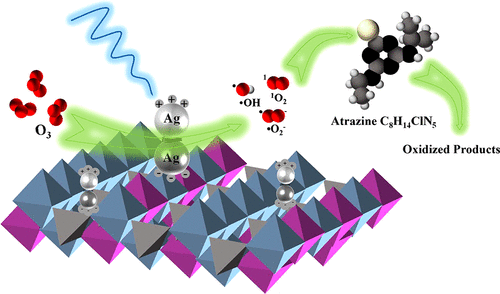当前位置:
X-MOL 学术
›
ACS ES&T Eng.
›
论文详情
Our official English website, www.x-mol.net, welcomes your feedback! (Note: you will need to create a separate account there.)
Plasmon-enhanced Catalytic Ozonation for Efficient Removal of Recalcitrant Water Pollutants
ACS ES&T Engineering Pub Date : 2021-03-23 , DOI: 10.1021/acsestengg.1c00020 Wenwen Yang 1 , Muntaseer Bunian 2 , Xiankun Chen 1 , Steve Heald 3 , Lei Yu 4 , Jianguo Wen 4 , Yu Lei 2 , Tingting Wu 1
ACS ES&T Engineering Pub Date : 2021-03-23 , DOI: 10.1021/acsestengg.1c00020 Wenwen Yang 1 , Muntaseer Bunian 2 , Xiankun Chen 1 , Steve Heald 3 , Lei Yu 4 , Jianguo Wen 4 , Yu Lei 2 , Tingting Wu 1
Affiliation

|
Ag-Doped MnFe2O4 catalyst (Ag/MnFe2O4) was synthesized by a simple sol–gel method followed by H2 reduction. Utilizing the localized surface plasmon resonance (LSPR) of Ag, ∼35-fold and ∼7-fold degradation rate increases for a representative ozone-resistant water pollutant (atrazine) were achieved with a low photon flux (∼10–10 Einstein L–1), as compared to ozonation and catalytic ozonation, respectively, which also outperformed the homogeneous peroxone (O3/H2O2) process. The plasmon-mediated enhancement was realized through energy transferred from plasmonic Ag nanostructures to ozone adsorptive sites during the LSPR decay, leading to an accelerated ozone decomposition and subsequent radical generation (e.g., ·OH, O2·–, and 1O2) at both existing and newly activated catalytic active sites. Ag LSPR also helps maintain Ag0 in an oxidizing aqueous environment, which is crucial to sustain the high catalytic activity. Because of these plasmonic effects, more than 90% removal was achieved in tap water under realistic water treatment conditions.
中文翻译:

等离子体增强催化臭氧氧化技术有效去除难处理的水污染物
通过简单的溶胶-凝胶法,然后还原H 2,合成了掺Ag的MnFe 2 O 4催化剂(Ag / MnFe 2 O 4)。利用银的局部表面等离子体共振(LSPR),在低光子通量(约10 –10爱因斯坦L – 1),分别与臭氧化和催化臭氧化相比,后者的性能也优于均相过氧化物(O 3 / H 2 O 2) 过程。等离子体激元介导的增强是通过在LSPR衰减过程中将能量从等离子体Ag纳米结构转移到臭氧吸附位点来实现的,从而导致臭氧加速分解并随后在自由基处生成自由基(例如·OH,O 2 · –和1 O 2)。现有和新激活的催化活性位点。Ag LSPR还有助于将Ag 0保持在氧化性水环境中,这对于维持高催化活性至关重要。由于这些等离激元效应,在实际的水处理条件下,自来水中的去除率达到90%以上。
更新日期:2021-05-14
中文翻译:

等离子体增强催化臭氧氧化技术有效去除难处理的水污染物
通过简单的溶胶-凝胶法,然后还原H 2,合成了掺Ag的MnFe 2 O 4催化剂(Ag / MnFe 2 O 4)。利用银的局部表面等离子体共振(LSPR),在低光子通量(约10 –10爱因斯坦L – 1),分别与臭氧化和催化臭氧化相比,后者的性能也优于均相过氧化物(O 3 / H 2 O 2) 过程。等离子体激元介导的增强是通过在LSPR衰减过程中将能量从等离子体Ag纳米结构转移到臭氧吸附位点来实现的,从而导致臭氧加速分解并随后在自由基处生成自由基(例如·OH,O 2 · –和1 O 2)。现有和新激活的催化活性位点。Ag LSPR还有助于将Ag 0保持在氧化性水环境中,这对于维持高催化活性至关重要。由于这些等离激元效应,在实际的水处理条件下,自来水中的去除率达到90%以上。



























 京公网安备 11010802027423号
京公网安备 11010802027423号